The Economics and Statistics Division maintains archives of previous publications for accountability purposes, but makes no updates to keep these documents current with the latest data revisions from Statistics Canada. As a result, information in older documents may not be accurate. Please exercise caution when referring to older documents. For the latest information and historical data, please contact the individual listed to the right.
<--- Return to Archive
For additional information relating to this article, please contact:
February 16, 2017EMPLOYMENT INSURANCE, DECEMBER 2016 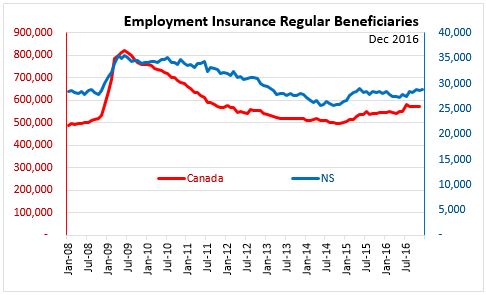
In December 2016, the number (seasonally adjusted) of Nova Scotians receiving regular Employment Insurance (EI) benefits increased by 220 persons (0.8 per cent) from the previous month to 28,860 and increased by 780 persons (2.8 per cent) over December 2015.
In December 2016, the number (seasonally adjusted) of Canadians receiving regular EI benefits decreased 0.6 per cent (-3,190 persons) from the previous month to 568,790. The number of regular EI beneficiaries increased by 23,130 (4.2 per cent) over December 2015, partially reflecting legislative changes to the EI program that came into effect in July 2016.
The number (seasonally adjusted) of Nova Scotians receiving regular EI benefits in December 2016 accounted for 5.9 per cent of the total labour force. In Canada, the number of EI beneficiaries accounted for 2.9 per cent of the total labour force.
On an annual basis, the annual average number of Nova Scotians receiving regular EI benefits decreased 0.2 per cent in 2016 compared to 2015. In Canada, the number increased by 5.0 per cent, reflecting legislative changes and significant increases in Alberta and Saskatchewan.
AGE
The majority (62.2 per cent) of regular EI recipients in Nova Scotia were in the 25 to 54 age group, who make up 62.8 per cent of the labour force. Although they account for 23.4 per cent of the labour force, 26.7 per cent of EI recipients were in the 55 years and over age group. A further 11.2 per cent of EI recipients were in the 15 to 24 age group, though they are 13.9 per cent of the labour force.
For people aged 55 years and over, EI beneficiaries accounted for 6.7 per cent of the labour force in the same age range. For the labour force between the ages of 25 and 54, EI beneficiaries accounted for 5.8 per cent of the total and for ages 15 to 24, they accounted for 4.7 per cent.
On a year-over-year basis, the number of beneficiaries in the 15 to 24 age group increased by 410 persons, the 25-54 age group increased by 10 persons, and the 55 years and over group increased by 350 persons.
Annually, the average annual number of beneficiaries increased by 2.1 per cent among 15-24 year olds and by 2.0 per cent among those 55 years and older. The number of beneficiaries between 25 and 54 years of age declined by 1.5 per cent.

COUNTIES
In December 2016, twelve counties reported higher regular EI beneficiaries compared to a year ago with four counties showing a decrease.
On an annual basis (Jan-Dec 2016 vs. Jan-Dec 2015, seasonally adjusted), EI beneficiaries are down 0.2 per cent in Nova Scotia as decreases in ten counties outweighed increases in eight, including the most populous county of Halifax.
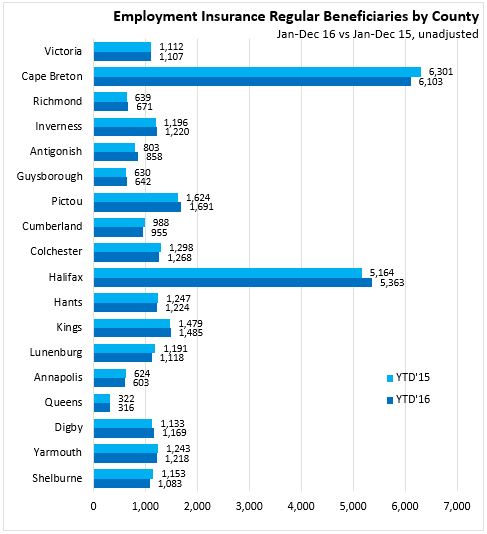
OCCUPATION
In Nova Scotia in December 2016, the highest number of EI recipients were last employed in the trades, transport and equipment operators occupations (9,290, or 32.2 per cent of the monthly total), followed by sales and service occupations (4,990 or 17.3 per cent of the total) and natural resources, agriculture and related occupations (3,850, or 13.3 per cent of the total).
On an annual basis, the number of EI beneficaries increased the most for recipients last employed in health occupations compared to the same period in 2015. The number of EI beneficiaries declined the most over this period for recipients that were last employed in arts, culture, recreation and sport.
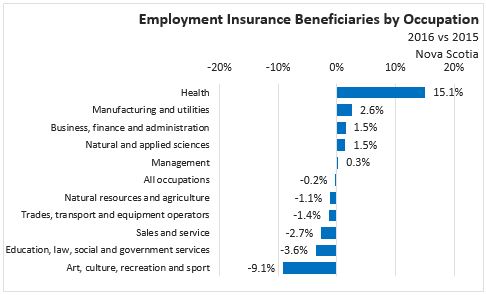
YEAR TO DATE - PROVINCES
Across the country, seven provinces saw year to date increases in EI beneficiaries. Alberta (+64.8 per cent) led provinces in year to date EI beneficiary growth, followed by Saskatchewan (+32.3 per cent) and Newfoundland and Labrador (+11.9 per cent). Quebec (-6.1 per cent) and Ontario (-6.0 per cent) posted declines in the number of EI beneficiaries. The average across Canada was a 5.0% increase in annual average EI beneficiaries.
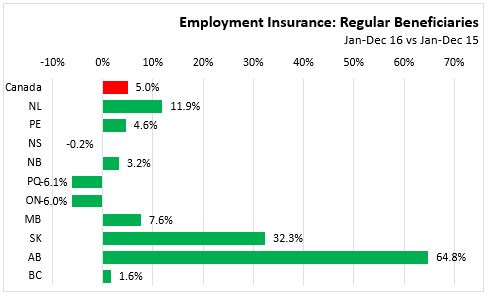
EI BENEFICIARIES AS A SHARE OF THE UNEMPLOYED BY PROVINCE
In Nova Scotia, EI beneficiaries accounted for 69.1 per cent of the unemployed in 2016, compared to a Canadian rate of 41.3 per cent. Across the country, EI beneficiaries accounted for the highest shares of the unemployed in the Atlantic provinces, led by Newfoundland and Labrador, Prince Edward Island, and New Brunswick. EI beneficiaries accounted for the lowest shares in Ontario, followed by British Columbia, Manitoba, and Alberta.
Note that due to differences in estimation methodology, it is possible for the reported number of EI beneficiaries to exceed the reported number of unemployed in a given jurisdiction, as it does in Newfoundland and Labrador in the chart below.
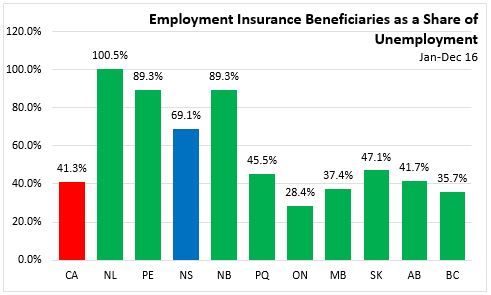
Note: Legislative changes to the EI program came into effect in July 2016. While some of these changes affected all EI regions across Canada, eligible claimants in the 15 regions that posted notable increases in unemployment received additional weeks of regular benefits starting in July. More information on the 2016 EI changes is available on Employment and Social Development Canada's (ESDC) website. As a result of the changes to the EI program, historical comparisons are not recommended, except in areas outside of the 15 EI regions where eligible claimants received additional weeks of benefits. These 15 EI regions are Newfoundland and Labrador, Northern Ontario, Sudbury, Northern Manitoba, Southern Saskatchewan, Northern Saskatchewan, Saskatoon, Southern Alberta, Northern Alberta, Calgary, Edmonton, Southern Interior British Columbia, Northern British Columbia, Whitehorse and Nunavut.
Statistics Canada CANSIM 276-0022 (Age, Province), 276-0043 (Occupation), 276-0035 (County level)
<--- Return to Archive